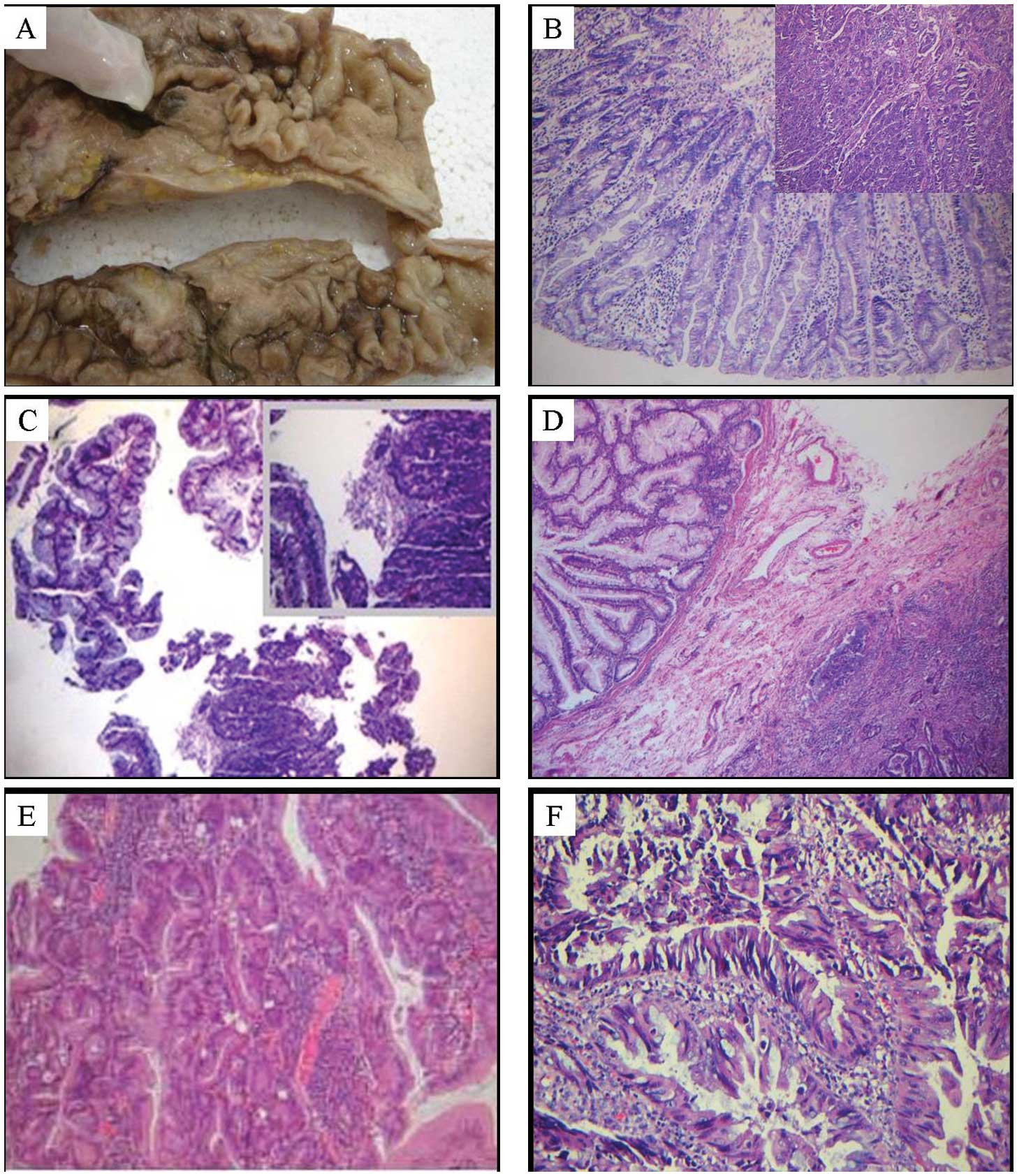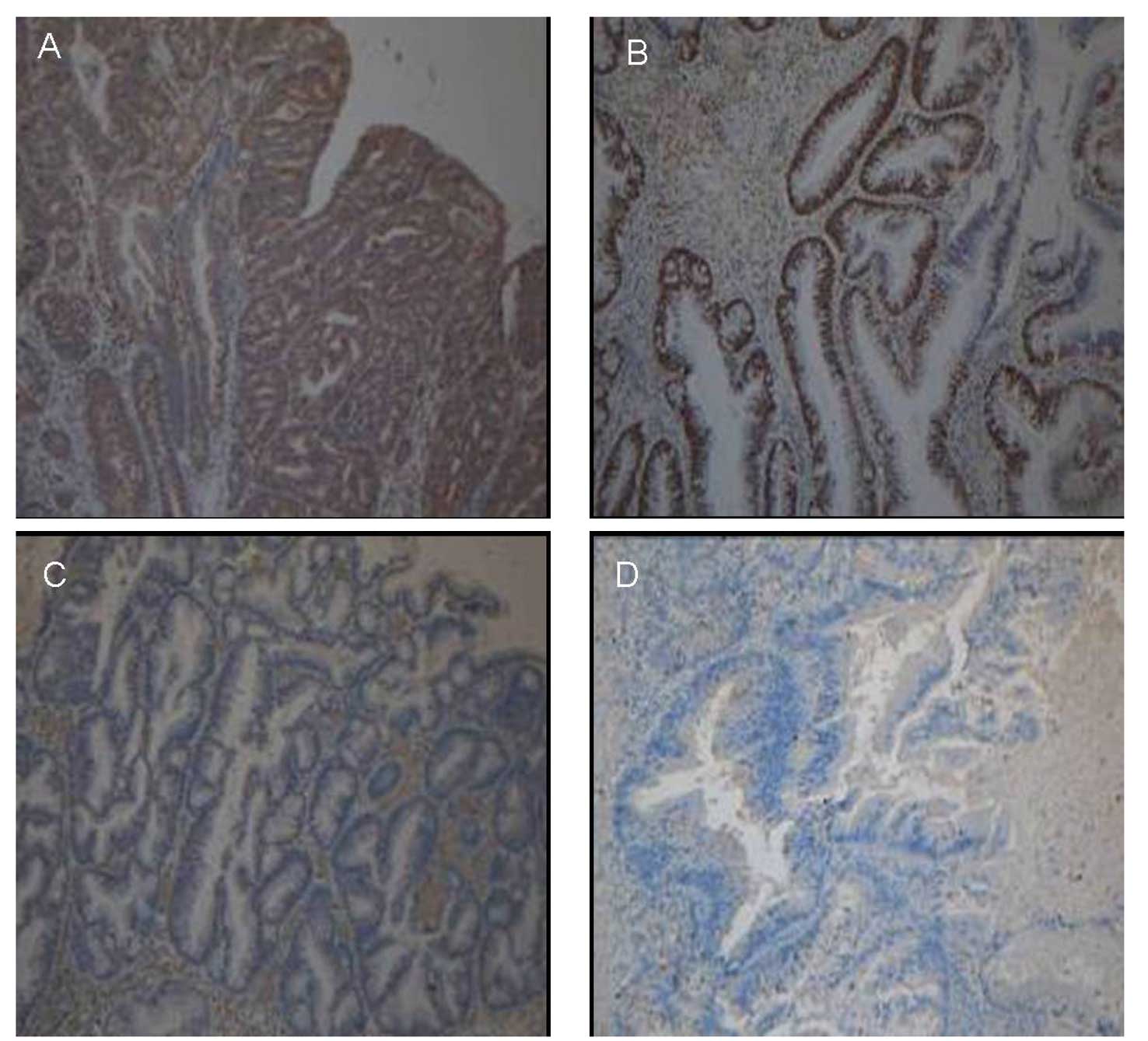|
1.
|
Snover DC: Update on the serrated pathway
to colorectal carcinoma. Hum Pathol. 42:1–10. 2011. View Article : Google Scholar : PubMed/NCBI
|
|
2.
|
Longacre TA and Fenoglio-Preiser CM: Mixed
hyperplastic adenomatous polyps/serrated adenomas. A distinct form
of colorectal neoplasia. Am J Surg Pathol. 14:524–537. 1990.
View Article : Google Scholar : PubMed/NCBI
|
|
3.
|
Snover DC, Ahnen DJ, Burt RW, et al:
Serrated polyps of the colon and rectum and serrated polyposis. WHO
Classification of Tumours of the Digestive System. Bosman FT,
Carneiro F, Hruban RH and Theise ND: 4th edition. IARC Press; Lyon:
pp. 160–165. 2010
|
|
4.
|
Hamilton SR, Bosman FT and Boffetta P:
Carcinoma of the colon and rectum. WHO Classification of Tumours of
the Digestive System. Bosman FT, Carneiro F, Hruban RH and Theise
ND: 4th edition. IARC Press; Lyon: pp. 134–146. 2010
|
|
5.
|
Lieberman DA, Prindiville S and Weiss DG:
Risk factors for advanced colonic neoplasia and hyperplastic polyps
in asymptomatic individuals. JAMA. 290:2959–2967. 2003. View Article : Google Scholar : PubMed/NCBI
|
|
6.
|
O’Brien MJ, Yang S, Clebanoff JL, Mulcahy
E, Farraye FA, Amorosino M and Swan N: Hyperplastic (serrated)
polyps of the colorectum: relationship of CpG island methylator
phenotype and K-ras mutation to location and histologic subtype. Am
J Surg Pathol. 28:423–434. 2004.PubMed/NCBI
|
|
7.
|
Snover DC, Jass JR, Fenoglio-Preiser C and
Batts KP: Serrated polyps of the large intestine: a morphologic and
molecular review of an evolving concept. Am J Clin Pathol.
124:380–391. 2005. View Article : Google Scholar : PubMed/NCBI
|
|
8.
|
Hawkins NJ and Ward RJ: Sporadic
colorectal cancers with microsatellite instability and their
possible origin in hyperplastic polyps and serrated adenomas. J
Natl Cancer Inst. 93:1307–1313. 2001. View Article : Google Scholar : PubMed/NCBI
|
|
9.
|
Torlakovic EE, Gomez JD, Driman DK,
Parfitt JR, Wang C, Benerjee T and Snover DC: Sessile serrated
adenoma (SSA) vs. tradition serrated adenoma (TSA). Am J Surg
Pathol. 32:21–29. 2008. View Article : Google Scholar : PubMed/NCBI
|
|
10.
|
Wang LP and Chen J: Concept and
pathological diagnosis of colorectal sessile serrated adenoma
closely associated with cancer. Chin J Diagn Pathol. 15:84–87.
2008.(In Chinese).
|
|
11.
|
Kudo Se, Lambert R, Allen JI, Fujii H,
Fujii T, Kashida H, Matsuda T, Mori M, Saito H, Shimoda T, Tanaka
S, Watanabe H, Sung JJ, Feld AD, Inadomi JM, O’Brien MJ, Lieberman
DA, Ransohoff DF, Soetikno RM, Triadafilopoulos G, Zauber A,
Teixeira CR, Rey JF, Jaramillo E, Rubio CA, Van Gossum A, Jung M,
Vieth M, Jass JR and Hurlstone PD: Nonpolypoid neoplastic lesions
of the colorectal mucosa. Gastrointest Endosc. 68:S3–S47. 2008.
View Article : Google Scholar : PubMed/NCBI
|
|
12.
|
Xu LZ and Yang WT: Criteria for
identification of immunohistochemical reaction results. Chin Oncol.
6:229–231. 1996.(In Chinese).
|
|
13.
|
Mäkinen MJ, George SM, Jernvall P, Mäkelä
J, Vihko P and Karttunen TJ: Colorectal carcinoma associated with
serrated adenoma - prevalence, histological features, and
prognosis. J Pathol. 193:286–294. 2001.PubMed/NCBI
|
|
14.
|
Winawer SJ, Fletcher RH, Miller L, Godlee
F, Stolar MH, Mulrow CD, Woolf SH, Glick SN, Ganiats TG, Bond JH,
Rosen L, Zapka JG, Olsen SJ, Giardiello FM, Sisk JE, Van Antwerp R,
Brown-Davis C, Marciniak DA and Mayer RJ: Colorectal cancer
screening: clincial guidelines and rationale. Gastroenterology.
112:594–642. 1997. View Article : Google Scholar : PubMed/NCBI
|
|
15.
|
Hiraoka S, Kato J, Fujiki S, Kaji E,
Morikawa T, Murakami T, Nawa T, Kuriyama M, Uraoka T, Ohara N and
Yamamoto K: The presence of large serrated polyps increases risk
for colorectal cancer. Gastroenterology. 139:1503–1510. 2010.
View Article : Google Scholar : PubMed/NCBI
|
|
16.
|
Lazarus R, Junttila OE, Karttunen TJ and
Mäkinen MJ: The risk of metachronous neoplasia in patients with
serrated adenoma. Am J Clin Pathol. 123:349–359. 2005. View Article : Google Scholar : PubMed/NCBI
|
|
17.
|
Song SY, Kim YH, Yu MK, Kim JH, Lee JM,
Son HJ, Rhee PL, Kim JJ, Paik SW and Rhee JC: Comparison of
malignant potential between serrated adenomas and traditional
adenomas. J Gastroenterol Hepatol. 22:1786–1790. 2007. View Article : Google Scholar : PubMed/NCBI
|
|
18.
|
Wang LP, Chen J, Ning HY, Zhang XZ, Cheng
J, Li L, Wang B, Dai XJ, Zhu HY, Miao JH and Wang L: Serrated
lesions of colon and their malignant potential. Zhonghua Bing Li
Xue Za Zhi. 39:447–451. 2010.(In Chinese).
|
|
19.
|
Snover DC, Jass JR, Fenoglio-Preiser C and
Batts KP: Serrated polyps of the large intestine: a morphologic and
molecular review of an evolving concept. Am J Clin Pathol.
124:380–391. 2005. View Article : Google Scholar : PubMed/NCBI
|
|
20.
|
Lu FI, van Niekerk de W, Owen D, Tha SP,
Turbin DA and Webber DL: Longitudinal outcome study of sessile
serrated adenomas of the colorectum: an increased risk for
subsequent right-sided colorectal carcinoma. Am J Surg Pathol.
34:927–931. 2010. View Article : Google Scholar
|
|
21.
|
Mäkinen M: Colorectal serrated
adenocarcinoma. Histopathology. 50:131–150. 2007.
|
|
22.
|
Sheridan TB, Fenton H, Lewin MR, Burkart
AL, Iacobuzio-Donahue CA, Frankel WL and Montgomery E: Sessile
serrated adenomas with low- and high-grade dysplasia and early
carcinomas: an immunohistochemical study of serrated lesions
‘caught in the act’. Am J Clin Pathol. 126:564–571. 2006.PubMed/NCBI
|
|
23.
|
Goldstein NS: Small colonic microsatellite
unstable adenocarcinomas and high-grade epithelial dysplasias in
sessile serrated adenoma polypectomy specimens: a study of eight
cases. Am J Clin Pathol. 125:132–145. 2006. View Article : Google Scholar
|
|
24.
|
Leggett B and Whitehall V: Role of the
serrated pathway in colorectal cancer pathogenesis.
Gastroenterology. 138:2088–2100. 2010. View Article : Google Scholar : PubMed/NCBI
|
|
25.
|
Kim KM, Lee EJ, Kim YH, Chang DK and Odze
RD: KRAS mutations in traditional serrated adenomas from Korea
herald an aggressive phenotype. Am J Surg Pathol. 34:667–675.
2010.PubMed/NCBI
|
|
26.
|
Tuppurainen K, Mäkinen JM, Junttila O,
Liakka A, Kyllönen AP, Tuominen H, Karttunen TJ and Mäkinen MJ:
Morphology and microsatellite instability in sporadic serrated and
non-serrated colorectal cancer. J Pathol. 207:285–294. 2005.
View Article : Google Scholar : PubMed/NCBI
|
|
27.
|
Huang CS, O’brien MJ, Yang S and Farraye
FA: Hyperplastic polyps, serrated adenomas, and the serrated polyp
neoplasia pathway. Am J Gastroenterol. 99:2242–2255. 2004.
View Article : Google Scholar : PubMed/NCBI
|

















